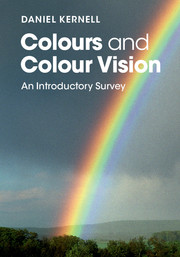Book contents
- Frontmatter
- Dedication
- Contents
- List of plates
- List of figures
- List of tables
- Preface
- 1 Colour vision in everyday life
- 2 The signals of colours: light and wavelengths
- 3 Colours and viewing conditions: not only local wavelengths
- 4 Our biological hardware: eye and brain
- 5 Eyes with unconventional properties: the ‘red-green blinds’
- 6 Other kinds of unconventional colour vision
- 7 Colour vision in different species of animals
- Appendices
- Appendix A Diagnosis and measurement of differences in colour vision
- Appendix B Specification and measurement of colours
- Appendix C Light and lighting
- Appendix D Digital cameras
- Appendix E Technical terms
- Notes
- References
- Index
- Plate section
Appendix D - Digital cameras
from Appendices
Published online by Cambridge University Press: 05 March 2016
- Frontmatter
- Dedication
- Contents
- List of plates
- List of figures
- List of tables
- Preface
- 1 Colour vision in everyday life
- 2 The signals of colours: light and wavelengths
- 3 Colours and viewing conditions: not only local wavelengths
- 4 Our biological hardware: eye and brain
- 5 Eyes with unconventional properties: the ‘red-green blinds’
- 6 Other kinds of unconventional colour vision
- 7 Colour vision in different species of animals
- Appendices
- Appendix A Diagnosis and measurement of differences in colour vision
- Appendix B Specification and measurement of colours
- Appendix C Light and lighting
- Appendix D Digital cameras
- Appendix E Technical terms
- Notes
- References
- Index
- Plate section
Summary
Our eyes are often said to be ‘camera-like’ (or, rather, our cameras are ‘eye-like’): using a lens, a picture of the surrounding world is projected onto the reverse side of the eye/camera, where it is somehow recorded and retained for later use. In our eyes, the recording and further processing happens using receptors and nerve cells. In analogue cameras, the recording is done using a light-sensitive film. In digital cameras, the film is replaced by a light-sensitive electronic sensor and the further processing is done using computer techniques. There are many interesting similarities and differences between our visual system (eyes and brain) and the functional properties of modern digital cameras. In this Appendix, I will concentrate on colour-associated aspects.
Sensor and colour analysis
The light sensor of a digital camera contains a huge number of light-sensitive picture elements (pixels), often about 10 million or more. There are three types of elements, each one reacting to a different range of wavelengths: R pixels for red, G pixels for green, B pixels for blue/violet; this wavelength selectivity is typically produced by placing a different optical filter on top of each kind of sensor element. The signals from the R, G and B pixels are analysed using an RGB model (cf. Plate 2.6). With methods similar to those of the CIE system, the RGB-signals may be used to calculate the colour to be produced in different portions of the picture. The RGB-models are directly derived from studies of our visual system, and these digital camera techniques may indeed seem to be very eye-like. However, there are also several evident differences between eyes and the RGB-organization of digital cameras.
Camera sensors often have their RGB-pixels arranged according to a so-called Bayer pattern (Plate D.1) with 25% R, 50% G and 25% B pixels; the name of this pattern comes from Bryce Bayer, who worked at Kodak in the 1970s. This pixel pattern gives the camera sensor a maximal light sensitivity within the green region of the spectrum (cf. eye sensitivity ‘In daylight’, Figure 4.4). However, in the retina the proportions of the various light-sensitive elements are quite different from those of the Bayer pattern (Section 4.3.1); for instance, the eye has only about 5% S cones (cf. 25% B pixels). Furthermore, the spatial distribution of the retinal cones is very heterogeneous and complex (Section 4.3.2).
- Type
- Chapter
- Information
- Colours and Colour VisionAn Introductory Survey, pp. 220 - 223Publisher: Cambridge University PressPrint publication year: 2016



